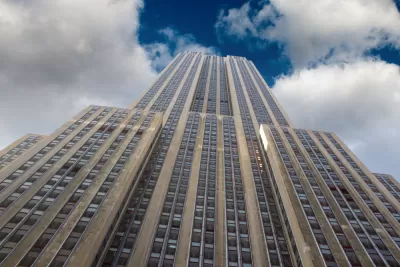The common claim that "high-rises kill streetlife" is often incorrect.

One common argument against tall residential buildings is that high-rises reduce a neighborhood’s livability by reducing its streetlife. For example, a few months ago I read a blog post claiming that "people who live in the high floors of a high-rise are less likely to leave their homes." I have lived in elevator buildings for the past couple of years, and can verify from personal experience that high-rise residents leave their homes for the same reasons that homeowners do: to go to work, to get groceries, and to perform all the other little functions that are necessary for a normal life. To be sure, a few people do work at home and get groceries delivered, but the overwhelming majority of people need to leave their homes on a regular basis, whether they live in a single-family house, a small multifamily building, or a high-rise.
Moreover, this argument doesn’t seem to be supported by what I have actually seen with my own eyes. New York City neighborhoods like Times Square and the Upper West Side certainly have plenty of elevator buildings, but these places have far more street life than many low-density suburbs or quiet rowhouse neighborhoods. Why? Because even if a few shut-ins are less likely to go outside than in a low-rise neighborhood, any negative results of this phenomenon are outweighed by the positive effects of density. So many people live, work and play near Times Square that its streets are far busier than those of a less dense rowhouse area such as Washington’s Capitol Hill (or even of higher-density rowhouse areas such as New York’s West Village). By contrast, my current neighborhood in Kansas City is not particularly lively—but my block (dominated by a 10-story building) seems no more lifeless than the street a block away dominated by three-story buildings, or the single-family home blocks west of my building.
In fact, high-rises may sometimes increase street life by increasing the popularity of city life and thereby increasing urban density. The "streetlife" argument against urban high-rises assumes that people who don’t live in high-rises would be happy to live in low-rise apartment buildings. In other words, it assumes that consumer preferences are: (1) highrises, (2) lowrises, and (3) suburbia. But some consumers may prefer (1) highrises, (2) suburbia, (3) lowrises, because they are only willing to live in the city if they can get the amenities that come with (1)- for example, doormen to enhance security (which are more common in high-rises than in smaller buildings) or elevators to reduce stress on aging knees and hips. In turn, these consumers are more likely to walk on city streets than if they lived in suburbia, thus increasing urban streetlife. And if they are business owners or executives, they are more likely to place their businesses in the city than if they lived in suburbia, thus causing even more people to walk on city streets.
To the extent that government uses the "streetlife" argument to prohibit or limit high-rise development, this argument has no logical stopping point. If the goal of public policy is to encourage people to leave their homes and use the streets, herding them into smaller buildings won’t really do very much, since some people can still be perfectly happy recreating in a rowhouse or single-family house. Instead, cities should make these homes as uninviting as possible; for example, cities could impose maximum apartment sizes instead of minimum sizes, and perhaps abolish all these pesky building codes that make apartments safe and comfortable. The Sustainable Cities blog post says that the high-rise "becomes your world, especially those which include a restaurant, market, gym and other amenities." The same could be said of an apartment or house that includes exercise equipment (one’s surrogate gym) or a kitchen (one’s surrogate restaurant)—so perhaps we should outlaw indoor kitchens or exercise equipment.
To be sure, a neighborhood composed of nothing but high-rise apartments can be monotonous. But the culprit is not the scale of buildings, but their use. A neighborhood with high-rises standing on top of ground-floor retail (such as Broadway on New York’s Upper West Side) will typically be far more lively than a block of nothing but apartments (such as West End Avenue a block away).

Trump Administration Could Effectively End Housing Voucher Program
Federal officials are eyeing major cuts to the Section 8 program that helps millions of low-income households pay rent.

Planetizen Federal Action Tracker
A weekly monitor of how Trump’s orders and actions are impacting planners and planning in America.

Ken Jennings Launches Transit Web Series
The Jeopardy champ wants you to ride public transit.

Crime Continues to Drop on Philly, San Francisco Transit Systems
SEPTA and BART both saw significant declines in violent crime in the first quarter of 2025.

How South LA Green Spaces Power Community Health and Hope
Green spaces like South L.A. Wetlands Park are helping South Los Angeles residents promote healthy lifestyles, build community, and advocate for improvements that reflect local needs in historically underserved neighborhoods.

Sacramento Plans ‘Quick-Build’ Road Safety Projects
The city wants to accelerate small-scale safety improvements that use low-cost equipment to make an impact at dangerous intersections.
Urban Design for Planners 1: Software Tools
This six-course series explores essential urban design concepts using open source software and equips planners with the tools they need to participate fully in the urban design process.
Planning for Universal Design
Learn the tools for implementing Universal Design in planning regulations.
Heyer Gruel & Associates PA
Ada County Highway District
Institute for Housing and Urban Development Studies (IHS)
City of Grandview
Harvard GSD Executive Education
Toledo-Lucas County Plan Commissions
Salt Lake City
NYU Wagner Graduate School of Public Service




























